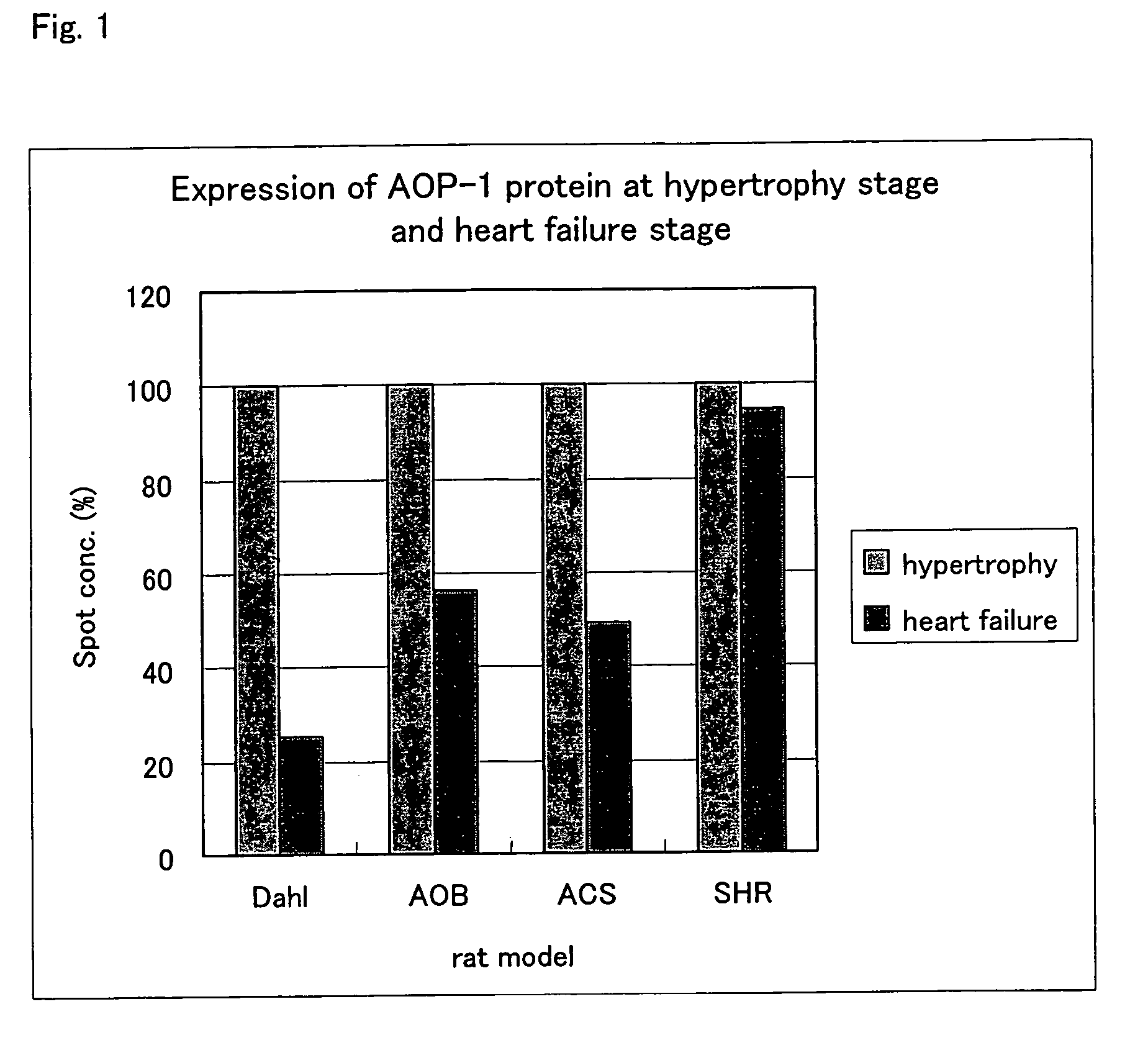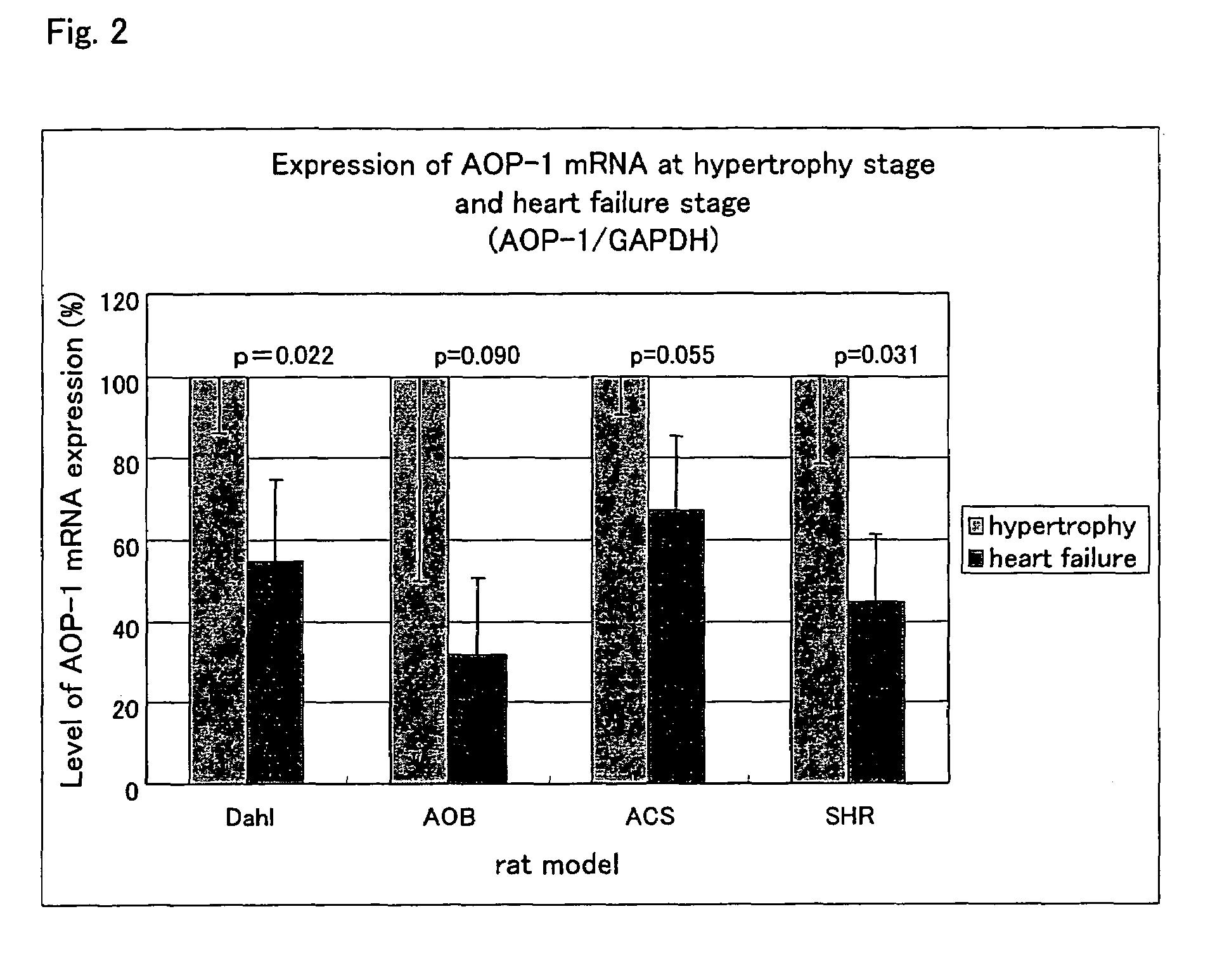Therapeutic methods and agents for diseases associated with decreased expression of AOP-1 gene or AOP-1
a technology of aop-1 and aop-1, which is applied in the direction of enzymology, drug composition, cardiovascular disorders, etc., can solve the problems of cellular death, more difficult to cure diseases, and cellular dysfunction, and achieve the effects of enhancing the production of aop-1, and enhancing the expression of aop-1
- Summary
- Abstract
- Description
- Claims
- Application Information
AI Technical Summary
Benefits of technology
Problems solved by technology
Method used
Image
Examples
example 1
Search for AOP-1 by Protein Two-Dimensional Electrophoresis of Proteins
1-1. Preparation of Pathologic Model Rats of Chronic Heart Failure and Collection of Left Ventricular Samples
A. Dahl Chronic Heart Failure Model Rats
[0125]Dahl rats are Sprague-Dawley strain rats separated into salt-sensitive rats (Dahl-S) susceptible to hypertension and salt-resistant rats (Dahl-R) resistant to hypertension at the third generation of passage charged with an 8% high salt diet. Kihara et al. of Kyoto University show that Dahl-S rats charged with an 8% high salt diet from 6-weeks of age developed compensatory left ventricular hypertrophy, then left ventricular dilatation accompanied by contraction failure, i.e. uncompensated chronic heart failure, and finally died of pulmonary congestion (Am. J. Physiol., 1994 Vol. 267, H2471-2482). This model can be prepared without any special techniques and can cause chronic heart failure in a short time, and also show clear separation between compensatory hyper...
example 2
Analysis of the Expression of AOP-1 Gene
[0142]The left ventricles obtained by the procedure described in Example 1-1, A to D were used as samples.
[0143]Total RNA was prepared from each left ventricle using ISOGEN (Nippon Gene) as instructed by the manufacturer and treated with DNase. TaqMan® Reverse Transcription Reagents (PE Applied Biosystems) were used to synthesize cDNA from 1 μg each of the total RNA treated with DNase in 50 μl of the reaction solution. Gene expression was analyzed by a real-time PCR assay system using ABI PRISM 7700 (PE Applied Biosystems). The primers for detecting AOP-1 and the TaqMan® probe were designed on the basis of the nucleotide sequence of mouse AOP-1 cDNA using a primer design software ABI PRISM Primer Express. Forward primer 5′TGCAGTTTCAGTGGATTCCCA3′ (SEQ ID NO: 7), reverse primer 5′TTCATGTGGCCCAAACCA3′ (SEQ ID NO: 8) TaqMan® probe 5′TCTTGCCTGGATCAACACCAAGAAAG3′ (SEQ ID NO:9)
[0144]Real-time PCR assay reaction was performed with 1 μl of said cDNA as...
example 3
Analysis of the Expression of TSA (PRx 2), CuZn-SOD, Mn-SOD and Catalase Genes
[0145]The left ventricles obtained by the procedure described in Example 1-1, E were used as samples.
[0146]Total RNA was prepared from each left ventricle using ISOGEN (Nippon Gene) as instructed by the manufacturer and treated with DNase. TaqMan® Reverse Transcription Reagents (PE Applied Biosystems) were used to synthesize cDNA from 1 μg each of the total RNA treated with DNase in 50 μl of the reaction solution. Gene expression was analyzed by a real-time PCR assay system using ABI PRISM 7700 (PE Applied Biosystems). The primers for detection and the TaqMan® probes were designed on the basis of the nucleotide sequences of rat TSA, CuZn-SOD, Mn-SOD and catalase cDNA using a primer design software ABI PRISM Primer Express. Rat TSA forward primer 5′CCCTCTGCTTGCTGATGTGACT3′ (SEQ ID NO: 10), reverse primer 5′CCTGTAAGCGATGCCCTCAT3′ (SEQ ID NO: 11), TaqMan® probe 5′AGCTTGTCCCAGAATTACGGCGTGTTGAA3′ (SEQ ID NO: 12...
PUM
| Property | Measurement | Unit |
|---|---|---|
| systolic blood pressures | aaaaa | aaaaa |
| systolic blood pressures | aaaaa | aaaaa |
| body weight | aaaaa | aaaaa |
Abstract
Description
Claims
Application Information
 Login to View More
Login to View More - R&D
- Intellectual Property
- Life Sciences
- Materials
- Tech Scout
- Unparalleled Data Quality
- Higher Quality Content
- 60% Fewer Hallucinations
Browse by: Latest US Patents, China's latest patents, Technical Efficacy Thesaurus, Application Domain, Technology Topic, Popular Technical Reports.
© 2025 PatSnap. All rights reserved.Legal|Privacy policy|Modern Slavery Act Transparency Statement|Sitemap|About US| Contact US: help@patsnap.com



